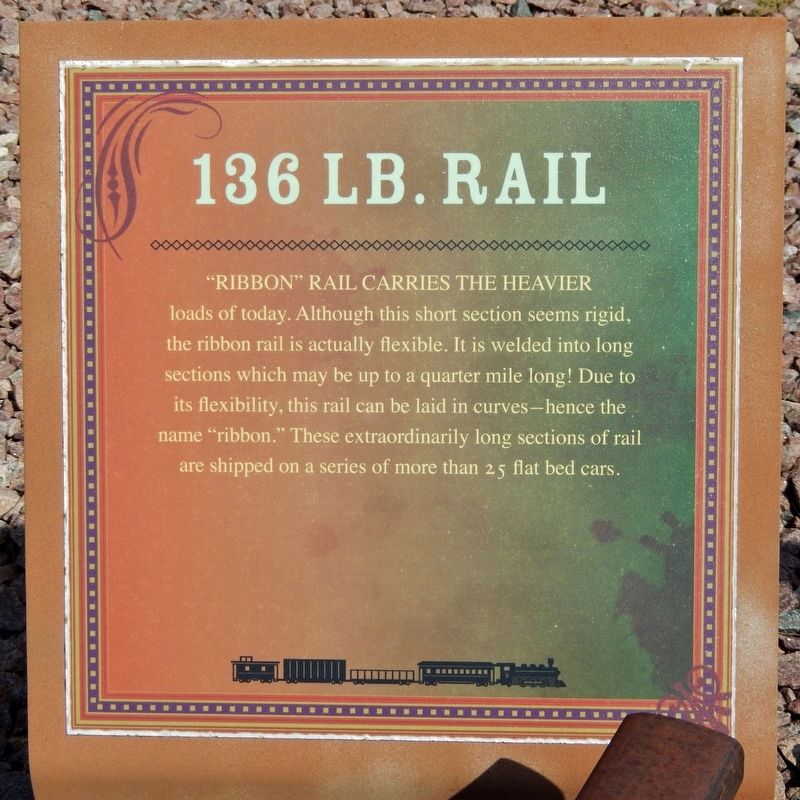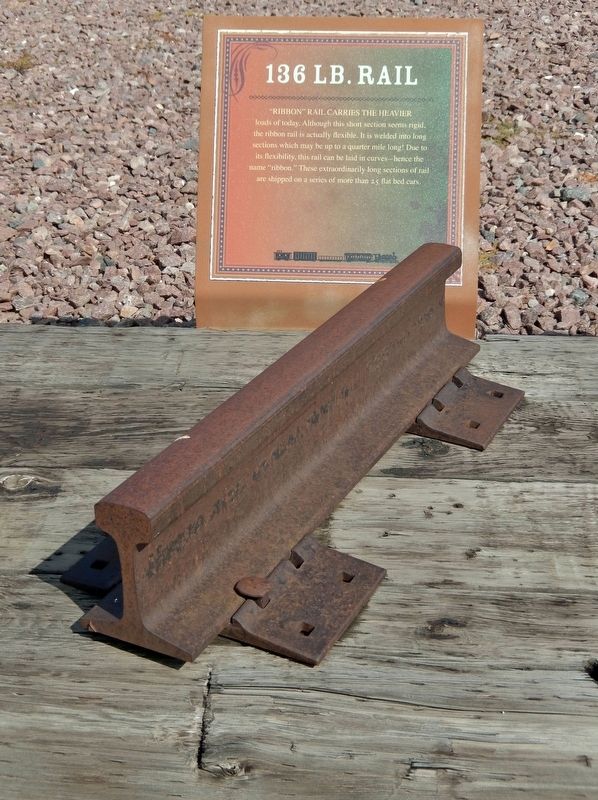Valley City in Barnes County, North Dakota — The American Midwest (Upper Plains)
136 Lb. Rail
“Ribbon” Rail carries the heavier loads of today. Although this short section seems rigid, the ribbon rail is actually flexible. It is welded into long sections which may be up to a quarter mile long! Due to its flexibility, this rail can be laid in curves — hence the name “ribbon.” These extraordinarily long sections of rail are shipped on a series of more than 25 flat bed cars.
Topics. This historical marker is listed in this topic list: Railroads & Streetcars.
Location. 46° 55.418′ N, 98° 0.368′ W. Marker is in Valley City, North Dakota, in Barnes County. Marker can be reached from West Main Street (Business U.S. 10/52) 0.1 miles west of Central Avenue North (County Highway 21), on the right when traveling west. The marker is located on the Rosebud Visitor Center grounds. Touch for map. Marker is at or near this postal address: 250 West Main Street, Valley City ND 58072, United States of America. Touch for directions.
Other nearby markers. At least 8 other markers are within walking distance of this marker. 90 Lb. Rail (here, next to this marker); Sun Kink Rail (here, next to this marker); 66 Lb. Rail (here, next to this marker); Rail Lines (here, next to this marker); Building the Railroad (here, next to this marker); Wood Beam (here, next to this marker); Valley City Street & Interurban Railroad (here, next to this marker); Rosebud Visitor Center Along the Byway (within shouting distance of this marker). Touch for a list and map of all markers in Valley City.
Related markers. Click here for a list of markers that are related to this marker. Rosebud Visitor Center Railroad History Exhibit
Also see . . . Railway Track (Wikipedia). Excerpt:
Most modern railways use continuous welded rail (CWR), sometimes referred to as ribbon rails or seamless rails. In this form of track, the rails are welded together by utilizing flash butt welding to form one continuous rail that may be several kilometres long. Because there are few joints, this form of track is very strong, gives a smooth ride, and needs less maintenance; trains can travel on it at higher speeds and with less friction. Welded rails are more expensive to lay than jointed tracks but have much lower maintenance costs. The first welded track was used in Germany in 1924 and has become common on main lines since the 1950s. North American practice is to weld ¼-mile-long segments of rail at a rail facility and load it on a special train to carry it to the job site. This train is designed to carry many segments of rail which are placed so they can slide off their racks to the rear of the train and be attached to the ties (sleepers) in a continuous operation.(Submitted on March 11, 2024, by Cosmos Mariner of Cape Canaveral, Florida.)
Credits. This page was last revised on March 11, 2024. It was originally submitted on March 10, 2024, by Cosmos Mariner of Cape Canaveral, Florida. This page has been viewed 52 times since then. Photos: 1, 2. submitted on March 11, 2024, by Cosmos Mariner of Cape Canaveral, Florida.

